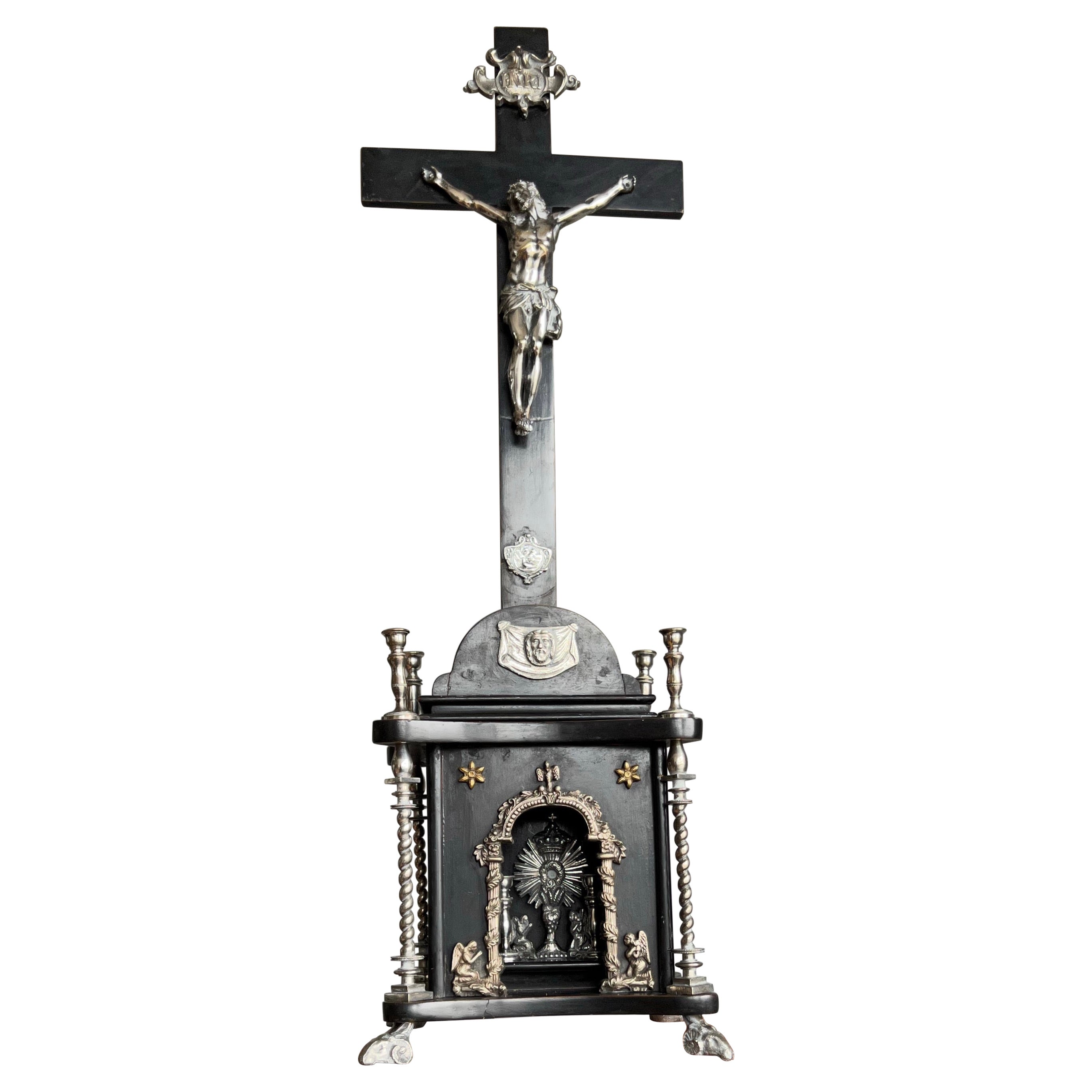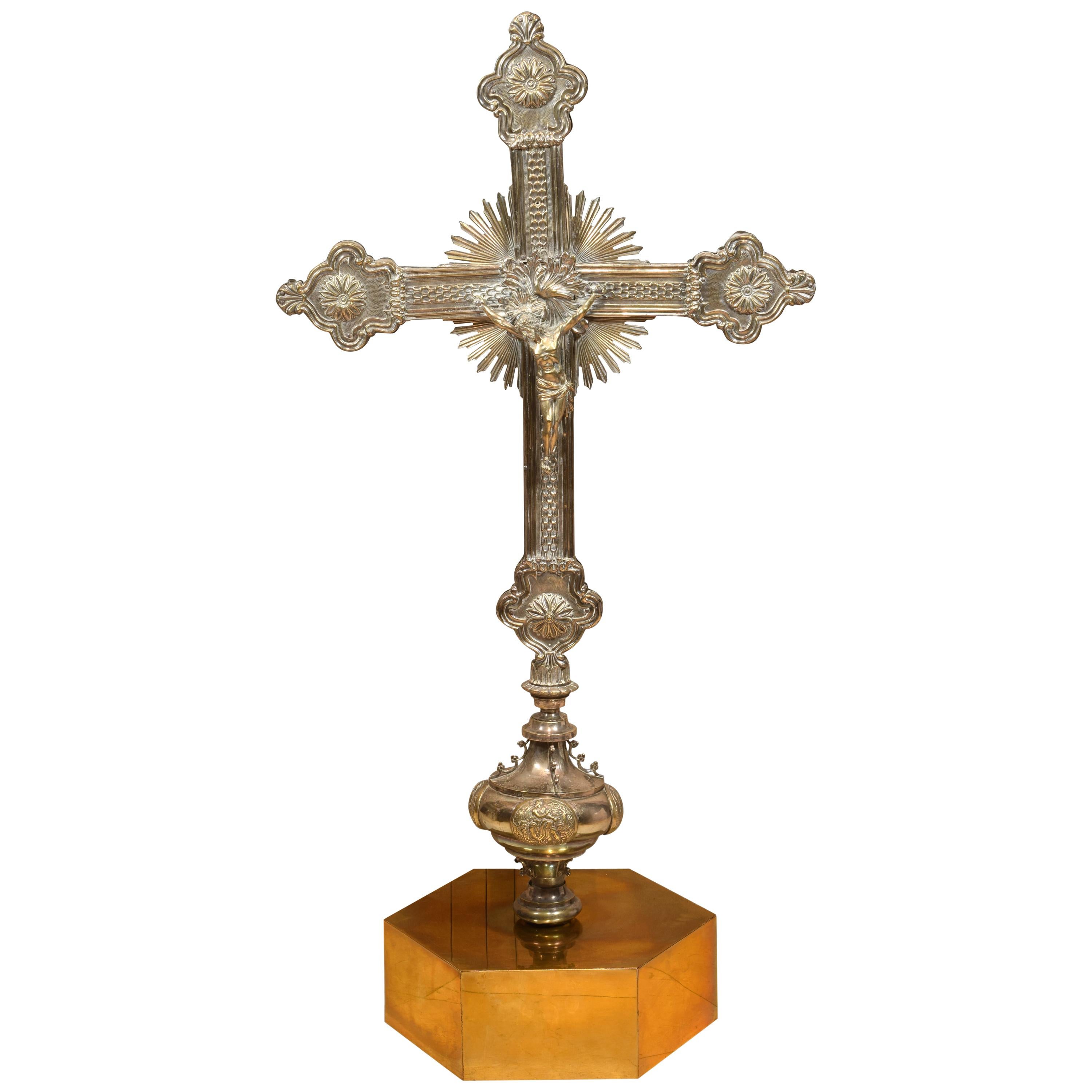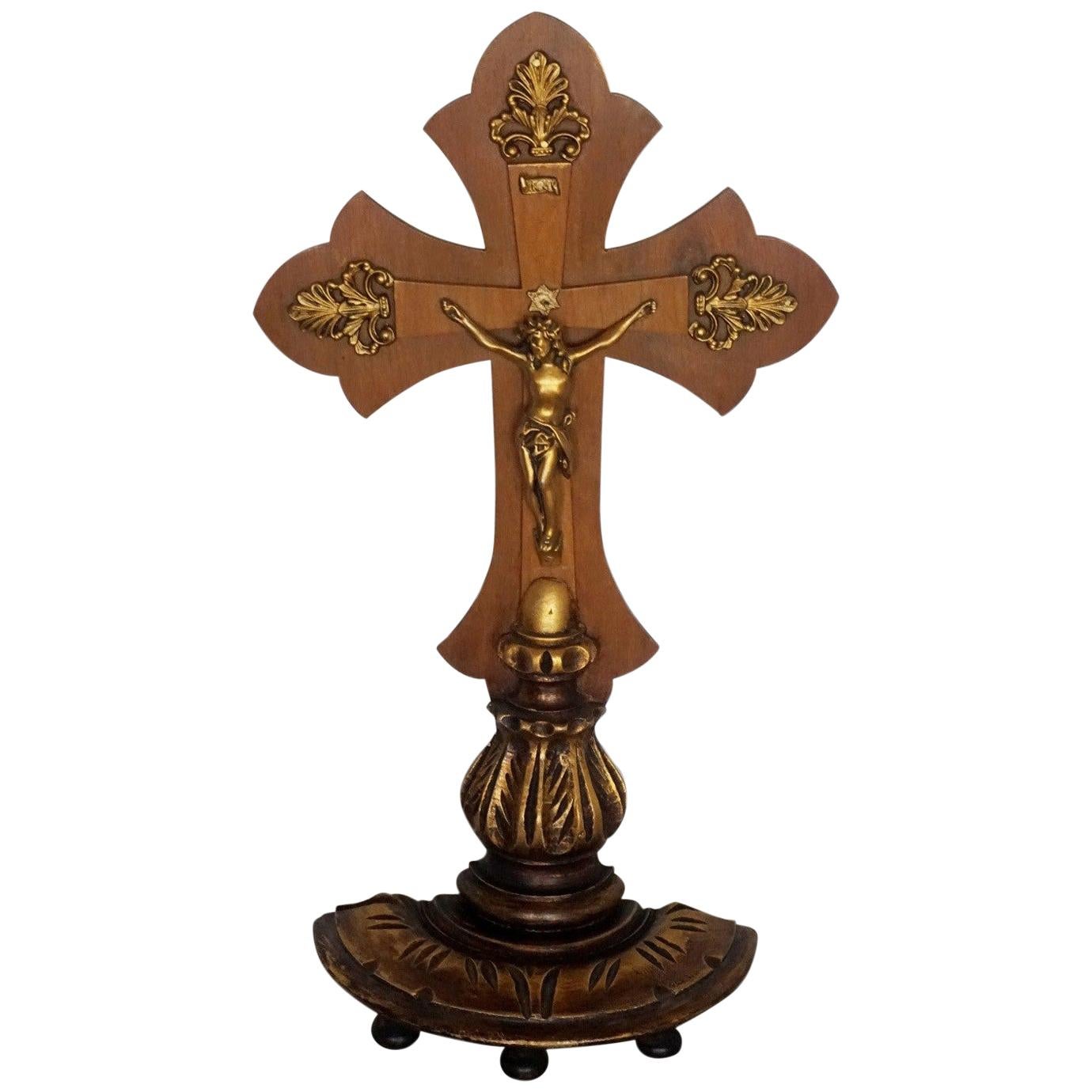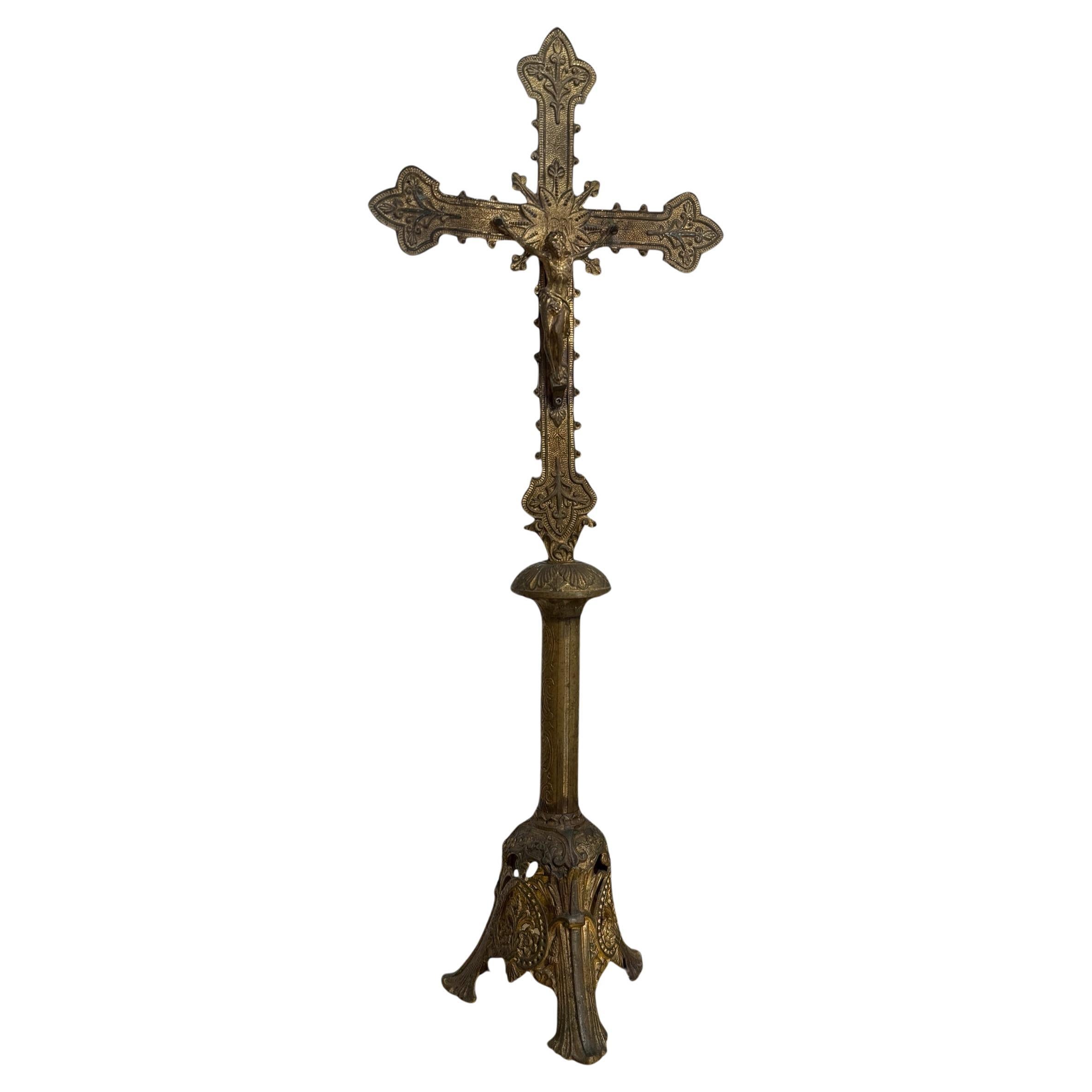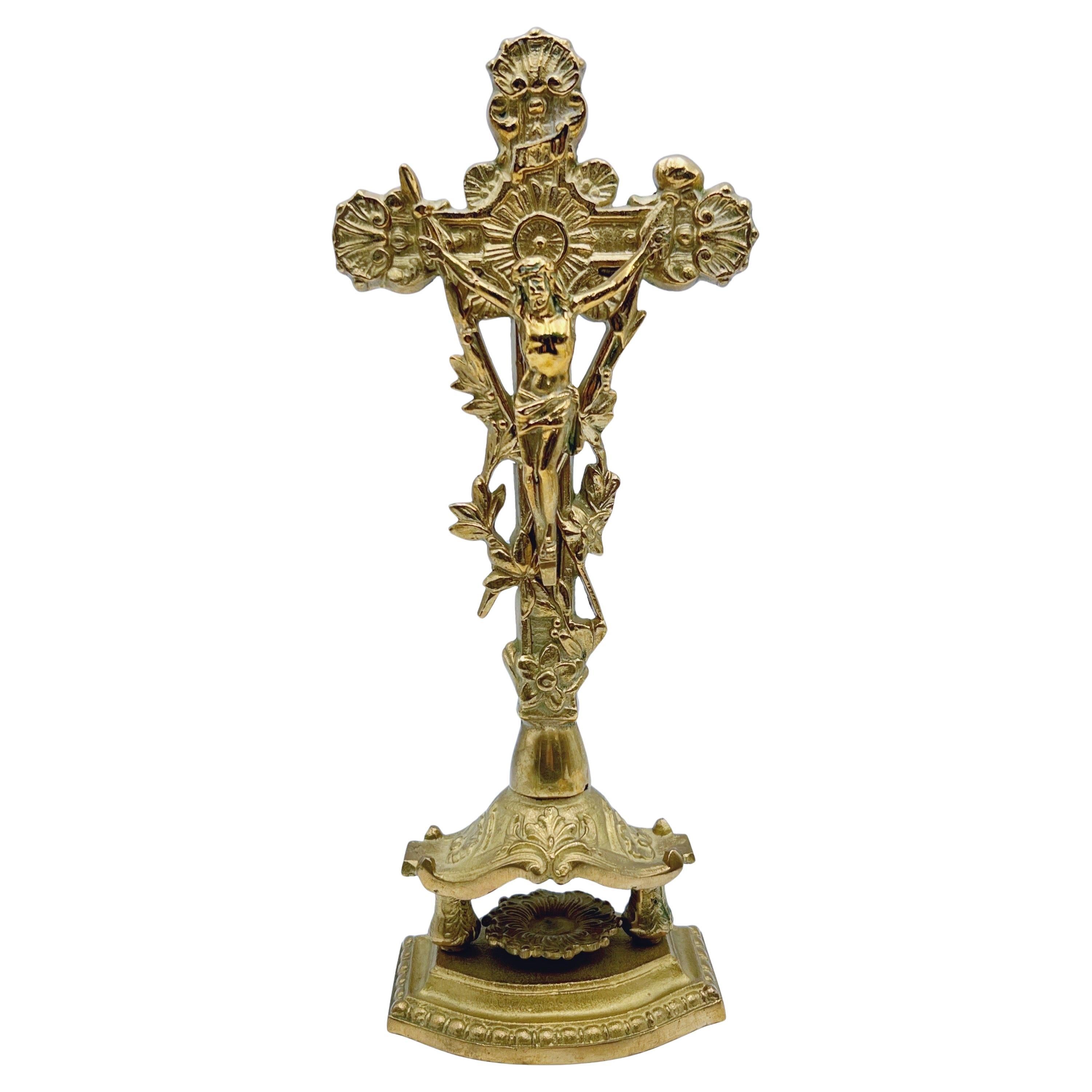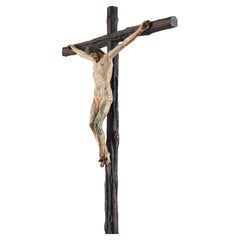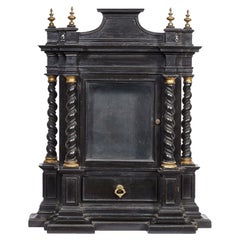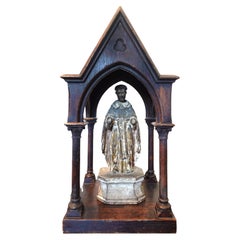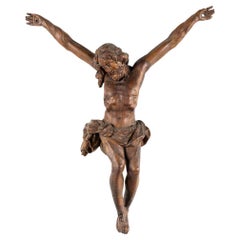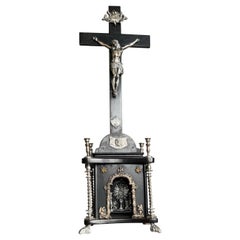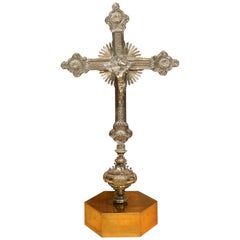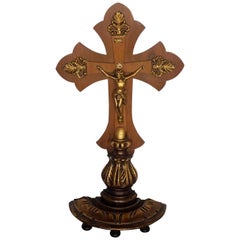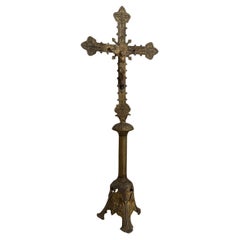Items Similar to Ebony Wood and Gilt Bronze Reliquary Altar Cross After Giambologna
Want more images or videos?
Request additional images or videos from the seller
1 of 11
Ebony Wood and Gilt Bronze Reliquary Altar Cross After Giambologna
$3,895
£2,955.44
€3,379.28
CA$5,440.26
A$6,048.83
CHF 3,158.36
MX$73,628.96
NOK 40,299.35
SEK 37,758.56
DKK 25,220.17
Shipping
Retrieving quote...The 1stDibs Promise:
Authenticity Guarantee,
Money-Back Guarantee,
24-Hour Cancellation
About the Item
Anonymous (corpus after a model by Giambologna)
circa 1700; Netherlandish or Northern Rhinish
Ebonized wood, gilt bronze appliques and statuettes, textiles and relics
Approximate size: 75 cm (h)
The present altar cross features a gilt bronze crucifix cast after a model by Giambologna, originally executed ca. 1579-89. In particular, the present figure of Christ follows examples finished by Giambologna’s assistant, Antonio Susini, like one example made for the altar of the Salviati Chapel in San Marco—Florence, Italy. However, the free reinterpretation of Christ’s hair and face could alternatively suggest the hand or influence of Taddeo Curradi, another friend and collaborator of Giambologna and Susini.
The present crucifix was likely cast later than the model’s invention, in the Netherlands or Northern Germany. It was not uncommon for Italian models to travel North of the Alps, and in particular, Giambologna’s assistant, Adriaen de Vries, was one such channel for the diffusion of such models into those territories.
The ebony wood construction of the present altar cross is tantamount to the talents of Flemish woodworkers of the period and another architecturally related example, also featuring a crucifix cast after Giambologna’s model, is found in the treasury of Cologne Cathedral (inv. RBA 135 379).
The figure of Christ and its accompanying skull, representing Golgotha, are probably earlier than the other bronzes present on the altar cross, cast probably during the 17th century, while the titulus, central applique nested in a niche and the flanking free-standing figures of St. John and Mary, in-the-round, are later inventions, perhaps of the early 18th century.
As with other objects-of-devotion, this distinctive altar may have been updated and reinterpreted over the duration of its history. In this case, the bronze crucifix has received a new context on the present altar. Some veneers may be later replacements and the relics may replace what could have originally been granite insets, replaced in the 18th century by relics backed by velvet. Some features of the woodwork could be later, like the base, stepped tier, and socle for the cross.
Condition: Rubbing on bronzes, commensurate with their age. Loss to a finger on the proper right arm of Christ and the perizonium along the hip. Finial appliques once flanked the ends of the crucifix, now lost. Velvet backing for the relics is possibly original (introduced during the 18th century) but shows signs of wear commensurate with age. The cross is slightly crooked due wear and exposure to various climate conditions over time. There are various dings, scratches and losses to the plinth, typical to works of this age and use. Overall, in fair condition and still retaining the essence of its former glory.
- Dimensions:Height: 25.5 in (64.77 cm)Width: 11.25 in (28.58 cm)Depth: 4.75 in (12.07 cm)
- Style:Baroque (Of the Period)
- Materials and Techniques:
- Place of Origin:
- Period:1690-1699
- Date of Manufacture:Unknown
- Condition:Replacements made: Some restorations or replacements over time, commensurate with age. Wear consistent with age and use.
- Seller Location:Leesburg, VA
- Reference Number:1stDibs: LU8166233261262
About the Seller
4.7
Vetted Professional Seller
Every seller passes strict standards for authenticity and reliability
Established in 2013
1stDibs seller since 2023
43 sales on 1stDibs
Typical response time: 2 hours
- ShippingRetrieving quote...Shipping from: Leesburg, VA
- Return Policy
Authenticity Guarantee
In the unlikely event there’s an issue with an item’s authenticity, contact us within 1 year for a full refund. DetailsMoney-Back Guarantee
If your item is not as described, is damaged in transit, or does not arrive, contact us within 7 days for a full refund. Details24-Hour Cancellation
You have a 24-hour grace period in which to reconsider your purchase, with no questions asked.Vetted Professional Sellers
Our world-class sellers must adhere to strict standards for service and quality, maintaining the integrity of our listings.Price-Match Guarantee
If you find that a seller listed the same item for a lower price elsewhere, we’ll match it.Trusted Global Delivery
Our best-in-class carrier network provides specialized shipping options worldwide, including custom delivery.More From This Seller
View AllRare and important painted bronze Crucifix after a model by Michelangelo
By Michelangelo Buonarroti
Located in Leesburg, VA
A rare and very fine bronze corpus of Christ after a model by Michelangelo, cast ca. 1597-1600 by Juan Bautista Franconio and painted in 1600 by Francisco Pacheco in Seville, Spain.
The present corpus reproduces a model attributed to Michelangelo. The best known example, lesser in quality, is one on display at the Metropolitan Museum of Art (MET).
The association of this corpus with Michelangelo was first brought to light by Manuel Gomez-Moreno (1930-33) who studied the wider circulated casts identified throughout Spain. The attribution to Michelangelo was subsequently followed by John Goldsmith-Phillips (1937) of the MET and again by Michelangelo expert, Charles de Tolnay (1960).
While Michelangelo is best known for his monumental works, there are four documented crucifixes he made. The best known example is the large-scale wooden crucifix for the Church of Santa Maria del Santo Spirito in Florence, made in 1492 as a gift for the Prior, Giovanni di Lap Bicchiellini, for allowing him to study the anatomy of corpses at the hospital there. In 1562, Michelangelo wrote two letters to his nephew, Lionardo, indicating his intention to carve a wooden crucifix for him. In 1563 a letter between Lionardo and the Italian sculptor Tiberio Calcagni, mentions this same crucifix (a sketch of a corpus on the verso of a sheet depicting Michelangelo’s designs for St. Peter’s Basillica [Palais des Beaux-Arts in Lille] may reproduce this). That Michelangelo was working on small corpora in the last years of his life is further evidenced by the small (26.5 cm) unfinished wooden crucifix located at the Casa Buonarroti, considered his last known sculptural undertaking. Michelangelo’s contemporary biographer, Giorgio Vasari additionally cites that Michelangelo, in his later years, made a small crucifix for his friend, Menighella, as a gift.
Surviving sketches also indicate Michelangelo’s study of this subject throughout his career, most notably during the end of his life but also during the 1530s-40s as he deepened his spiritual roots. The occasional cameo of crucified Christ’s throughout his sketched oeuvre have made it challenging for scholars to link such sketches to any documented commissions of importance. All the while, in consideration that such objects were made as gifts, it is unlikely they should be linked with commissions.
Nonetheless, a number of theories concerning Michelangelo’s sketches of Christ crucified have been proposed and some may regard the origin of the present sculpture. It has been suggested that the corpus could have its impetus with Michelangelo’s work on the Medici Chapel, whose exclusive design was given to the master. It is sensible smaller details, like an altar cross, could have fallen under his responsibility (see for example British Museum, Inv. 1859,0625.552). Others have noted the possibility of an unrealized large marble Crucifixion group which never came to fruition but whose marble blocks had been measured according to a sheet at the Casa Buonarroti.
A unique suggestion is that Michelangelo could have made the crucifix for Vittoria Colonna, of whom he was exceedingly fond and with whom he exchanged gifts along with mutual spiritual proclivities. In particular, Vittoria had an interest in the life of St. Bridget, whose vision of Christ closely resembles our sculpture, most notably with Christ’s proper-left leg and foot crossed over his right, an iconography that is incredibly scarce for crucifixes. The suggestion could add sense to Benedetto Varchi’s comment that Michelangelo made a sculpted “nude Christ…he gave to the most divine Marchesa of Pescara (Vittoria Colonna).”
Of that same period, two sketches can be visually linked to our sculpture. Tolnay relates it to a sketch of a Crucified Christ at the Teylers Museum (Inv. A034) of which Paul Joannides comments on its quality as suggestive of preparations for a sculptural work. Joannides also calls attention to a related drawing attributed to Raffaello da Montelupo copying what is believed to be a lost sketch by Michelangelo. Its relationship with our sculpture is apparent. Montelupo, a pupil of Michelangelo’s, returned to Rome to serve him in 1541, assisting with the continued work on the tomb of Pope Julius II, suggesting again an origin for the corpus ca. 1540.
The earliest firm date that can be given to the present corpus is 1574 where it appears as a rather crudely conceived Crucifixion panel, flanked by two mourners in low-relief and integrally cast for use as the bronze tabernacle door to a ciborium now located at the Church of San Lorenzo in Padula. Etched in wax residue on the back of the door is the date, 27 January 1574, indicating the corpus would have at least been available as a model by late 1573.
The Padula tabernacle was completed by Michelangelo’s assistant, Jacopo del Duca and likely has its origins with Michelangelo’s uncompleted tabernacle for the Basilica of St. Mary of the Angels in Rome.
The impetus for the Padula tabernacle’s Crucifixion panel begins with a series of late Crucifixion sketches by Michelangelo, depicting a scene of Christ crucified and flanked by two mourners (see British Museum Inv. 1895.0915.510; Ashmolean Museum Inv. 1846.89, KP II 343 recto; Windsor Castle RCIN 912761 recto; and Louvre Inv. 700). A faintly traced block possibly intended for sculpting the sketch of the crucified Christ on its recto was discovered by Tolnay on a version of the composition at Windsor Castle. The Windsor sketch and those related to it appear to have served as preparatory designs for what was probably intended to become the Basilica of St. Mary’s tabernacle door. Vasari documents that the project was to be designed by Michelangelo and cast by his assistant, Jacopo del Duca. Michelangelo died before the commission was complete, though on 15 March 1565, Jacopo writes to Michelangelo’s nephew stating, “I have started making the bronze tabernacle, depending on the model of his that was in Rome, already almost half complete.” Various circumstances interrupted the completion of the tabernacle, though its concept is later revitalized by Jacopo during preparations to sell a tabernacle, after Michelangelo’s designs, to Spain for Madrid’s El Escorial almost a decade later. The El Escorial tabernacle likewise encountered problems and was aborted but Jacopo successfully sold it shortly thereafter to the Carthusians of Padula.
An etched date, 30 May 1572, along the base of the Padula tabernacle indicates its framework was already cast by then. A 1573 summary of the tabernacle also describes the original format for the door and relief panels, intended to be square in dimension. However, a last minute decision to heighten them was abruptly made during Jacopo’s negotiations to sell the tabernacle to King Phillip II of Spain. Shortly thereafter the commission was aborted. Philippe Malgouyres notes that the Padula tabernacle’s final state is a mixed product of the original design intended for Spain’s El Escorial, recycling various parts that had already been cast and adding new quickly finished elements for its sale to Padula, explaining its unusually discordant quality, particularly as concerns the crudeness of the door and relief panels which were clearly made later (by January 1574).
Apart from his own admission in letters to Spain, it is apparent, however, that Jacopo relied upon his deceased master’s designs while hastily realizing the Padula panels. If Michelangelo had already earlier conceived a crucifix model, and Jacopo had access to that model, its logical he could have hastily employed it for incorporation on the door panel to the tabernacle. It is worth noting some modifications he made to the model, extending Christ’s arms further up in order to fit them into the scale of the panel and further lowering his chin to his chest in order to instill physiognomic congruence. A crude panel of the Deposition also follows after Michelangelo’s late sketches and is likewise known by examples thought to be modifications by Jacopo based upon Michelangelo’s initial sculptural conception (see Malgouyres: La Deposition du Christ de Jacopo del Duca, chef-d’oeuvre posthume de Michel-Ange).
Jacopo’s appropriation of an original model by Michelangelo for more than one relief on the Padula tabernacle adds further indication that the crucifix was not an object unique to Jacopo’s hand, as few scholars have posited, but rather belongs to Michelangelo’s original...
Category
Antique 16th Century Renaissance Figurative Sculptures
Materials
Bronze
An early 18th century Florentine Ebonized Wood Aedicule Case
Located in Leesburg, VA
An early 18th century Florentine ebonized wood aedicule case with gilt metal embellishments
Ambit of Leonard van der Vinne
Possibly first decade of the 18th century; Florence, Italy
Approximate size: 83.5 (h) x 69 (w) x 23 (d) cm
The cabinet’s centralized glass door is flanked by thick spiraling Solomonic columns surmounting a lower drawer. To the rear of the cabinet, the motif repeats in an eloquent display of perspectival treatment. The overall work is supported by a tiered base, elegantly conceived, and the cabinet is topped by a handsome pediment flanked by square plinths crested by gilt metal finials and an openwork frieze.
The cabinet’s tempered and moderate form suggests an origin probably during the first decade or quarter of the 18th century. Although utilitarian in concept, the reserved and sublime expressiveness of this cabinet is managed with a quality and care respective of the influence of Florentine ebony cabinetry work conceived in the Galleria dei lavori or Grand Ducal Workshops of the 18th century Medici dynasty. In particular, its base mouldings echo a remarkable Night Clock...
Category
Antique Early 18th Century Italian Baroque Vitrines
Materials
Brass
18th century Antique Wood-carved Santo figure in later Tabernacle
Located in Leesburg, VA
18th century Antique Wood-carved Santo figure in later Tabernacle
Anonymous
Spain or Spanish Americas; 18th century
Polychrome wood (santo); oak (tabernacle)
Approximate size: 18.5...
Category
Antique Mid-18th Century Spanish Spanish Colonial Figurative Sculptures
Materials
Wood, Oak
A Rustic Wooden 17th century Baroque Flemish Corpus of Christ
Located in Leesburg, VA
Anonymous
Belgium; ca. 1650-1700
Wood (walnut?)
Approximate size: 22.75 (h) x 18.5 (w) x 10 (d) in.
The scale of this sculpture indicates its original setting was either in the cen...
Category
Antique Late 17th Century Belgian Baroque Wall-mounted Sculptures
Materials
Walnut
An antique 18th century Walnut European Santos - Saint figure on a plinth
Located in Leesburg, VA
An antique 18th century Walnut Figural Statue of Saint Peter on a plinth
Anonymous
Northern Europe, probably Belgium; first-half of the 18th century
Walnut
Approximate size: 17 (h) x 4.25 (w) x 4.25 (d) in.
The present sculpture, perfectly suited for a curiosity cabinet or English-European country styled home, was likely realized for a church side chapel or choir stall niche. The serious look of the saint’s face...
Category
Antique Early 18th Century Belgian Baroque Figurative Sculptures
Materials
Walnut
A tall gilt brass European Gothic Revival pricket candlestick
Located in Leesburg, VA
A tall gilt brass European Gothic Revival pricket candlestick
Anonymous
Europe; first-half 20th century
Gilt Brass
Approximate size: 29 (h) x 6 (w) x 6 (d) in.
A tall gilt brass E...
Category
Early 20th Century Belgian Gothic Revival Candlesticks
Materials
Brass
You May Also Like
Antique Altar Crucifix Detailed Silvered Bronze Sculpture of Christ & Monstrance
Located in Lisse, NL
Unique table crucifix and a wonderful work of religious art.
For us the most powerful statement will always be 'the truth will set you free'. It is what we have learned most from th...
Category
Antique Mid-19th Century European Gothic Revival Religious Items
Materials
Bronze, Silver
Gilded Bronze Processional Cross Top, 20th Century, after Earlier Models
Located in Madrid, ES
End of processional cross. Ormolu, 20th century.
Latin cross with straight arms with decoration of tongues between moldings on both fronts, rays at the intersection of the arms, an...
Category
20th Century Spanish Baroque Religious Items
Materials
Bronze
Vintage Portuguese Handcrafted Wooden Stand Cross with Gilt Bronze Christ
Located in Frankfurt am Main, DE
Vintage handcrafted wooden stand cross with gilt bronze Christ and ornaments on a beautiful carved wooden base, Portugal, 1930-1939.
Measures: Height 19...
Category
Antique Mid-18th Century Italian Gothic Revival Religious Items
Materials
Bronze
French Gilded Bronze Altar Crucifix, 19th Century
Located in NICE, FR
An 19th-century French altar crucifix crafted in richly gilded bronze. This ecclesiastical piece stands on a tri-lobed base, each panel featuring a finely detailed medallion represen...
Category
Antique Late 19th Century French Napoleon III Religious Items
Materials
Bronze
Antique/Vintage Gothic Altar Table Crucifix, Brass /Bronze Table Standing Cross
Located in Skien, NO
Richly Decorated Free-Standing Table Crucifix / Cross & Corpus of Christ from the first half of the 20th century.
Gothic style, crafted from brass/bronze, with a beautiful patina. I...
Category
20th Century European Gothic Revival Figurative Sculptures
Materials
Brass, Bronze
Large Cross with Christ from the 18th Century
Located in Madrid, ES
Large cross with christ from the 18th century. The cross is decorated with tortoise shell, ivory and ebony. The christ is sculpted in high quality ...
Category
Antique 18th Century Italian Baroque Figurative Sculptures
Materials
Wood
